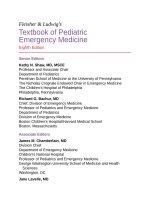Pediatric emergency medicine trisk 0209 0209
Bạn đang xem bản rút gọn của tài liệu. Xem và tải ngay bản đầy đủ của tài liệu tại đây (118.41 KB, 1 trang )
Well-executed ECC is the primary treatment for cardiopulmonary arrest. The
AHA 2015 Guidelines Update continues to recommend the following: push hard
(1 ⁄3 chest diameter), push fast (at least 100/min), allow full chest recoil, minimize
interruptions (<10 seconds) in chest compressions, avoid hyperventilation (8 to
10 beats per minute [bpm]), and change rescuers at least every 2 minutes. With
the patient on a firm surface, compress the lower half of the sternum, avoiding the
xiphoid process. The compression depth is about one-third to one-half the AP
diameter of the chest or 2 in in children and 1½ in in infants. For infants (<1
year), the Thaler or two-thumb–encircling hands technique is the preferred
method for health care providers ( Fig. 9.10 ). The recommended rate of
compressions for all ages except neonates is at 100 to 120 compressions/min. The
duration of the compression and the relaxation phases should be equal. Blood
flow and cardiac output are impaired by incomplete chest wall release that occurs
when the rescuer leans over the patient or does not pause at the end of the
compression phase. Prior to the establishment of an advanced airway,
compressions and ventilations should be coordinated in a 15:2 ratio (>1 rescuer) (
Table 9.5 ). Once the airway has been secured, coordination of compressions and
rescue breathing is no longer necessary. Interruptions in chest compressions result
in diminished cardiac output and are associated with poorer outcomes.
FIGURE 9.10 External cardiac compression using the Thaler method of thumbs encircling the
chest. A: Infant receiving chest compressions with thumb 1 fingerbreadth below the nipple line
and hands encircling chest. B: Hand position for chest encirclement technique for external chest
compressions in neonates. Thumbs are side by side over the lower third of the sternum. In the
small newborn, thumbs may need to be superimposed (inset ).









